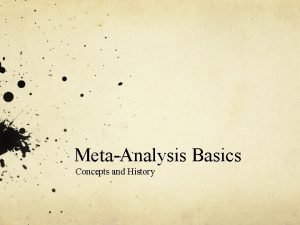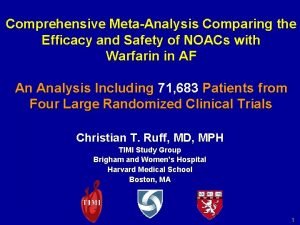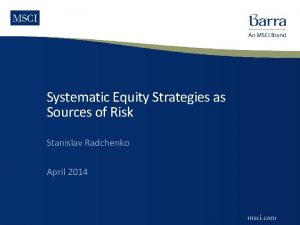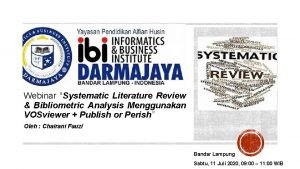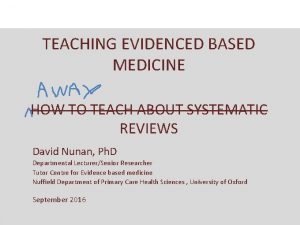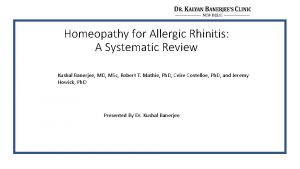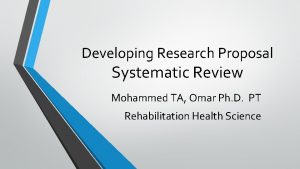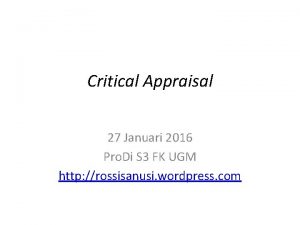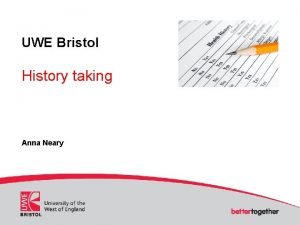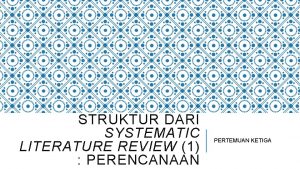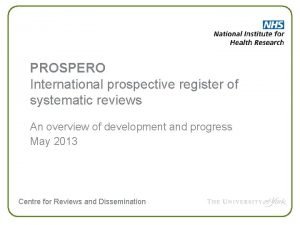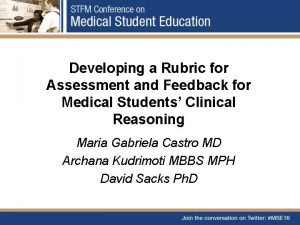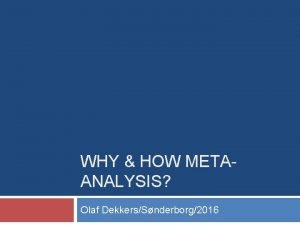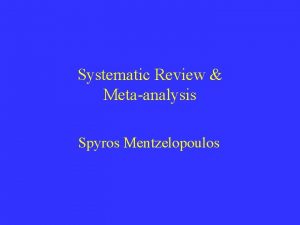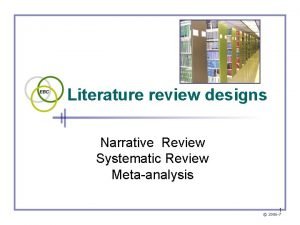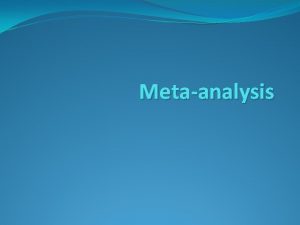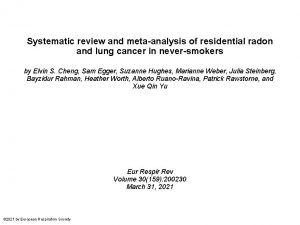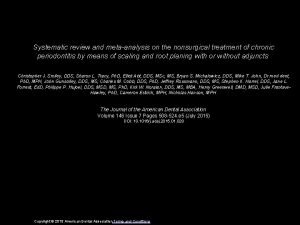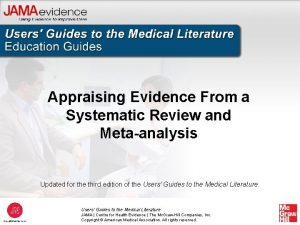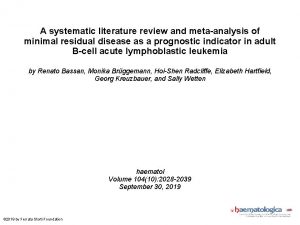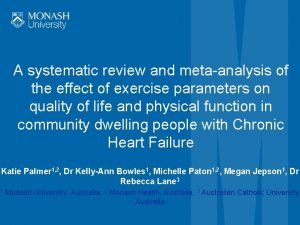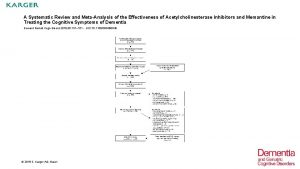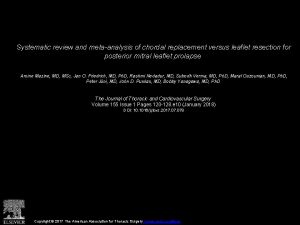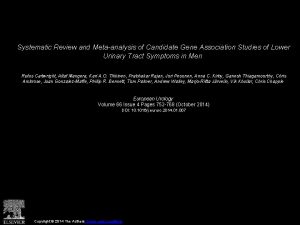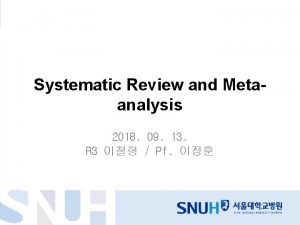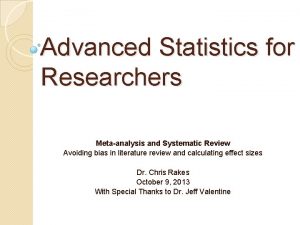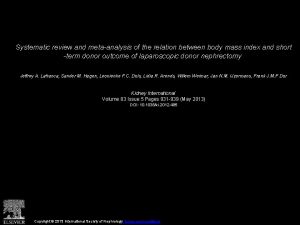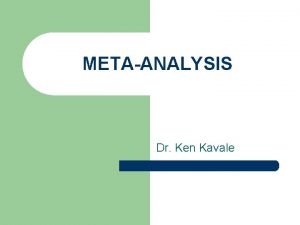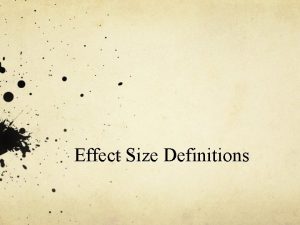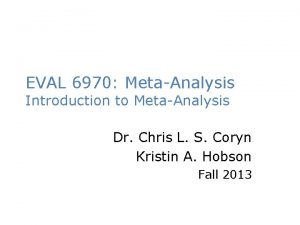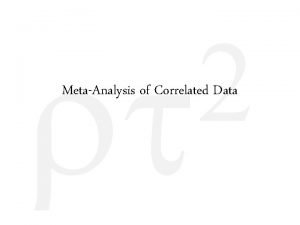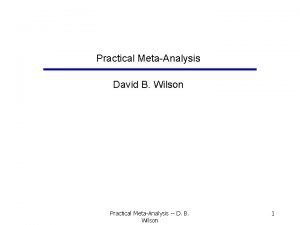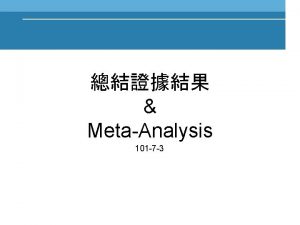Systematic Review and MetaAnalysis on Management Strategies for































- Slides: 31

Systematic Review and Meta-Analysis on Management Strategies for Asymptomatic Severe Aortic Stenosis Philippe Généreux, MD Associate Professor of Medicine, Interventional Cardiologist, Hôpital du Sacré-Coeur de Montréal, Québec, Canada Director, Angiographic Core Laboratory Cardiovascular Research Foundation, New York, NY CRT July 6 th 2016

Disclosure Statement of Financial Interest Within the past 12 months, I or my spouse/partner have had a financial interest/arrangement or affiliation with the organization(s) listed below • Edwards Life. Sciences ¡ Consultant, Speaker Fees, Proctor

Recommendations and Levels of Evidence for Diagnosis, Follow-up, and Timing of Aortic Valve Replacement in Patients With Asymptomatic Severe Aortic Stenosis ACC/AHA Indications for aortic valve replacement Left ventricular ejection fraction 50% Undergoing other cardiac surgery Symptoms on exercise test clearly related to aortic stenosis Decreased exercise tolerance Exercise fall in systolic blood pressure Very severe AS (PV 5. 0 m/s [ACC]; >5. 5 m/s [ESC] and low surgical risk Rate of PV progression ≥ 0. 3 m/s per year and low surgical risk Repeatedly markedly elevated natriuretic peptide and low surgical risk Increase of MG with exercise by >20 mm. Hg and low surgical risk Excessive LVH in the absence of hypertension and low surgical risk Diagnostic Transthoracic echocardiography as the initial diagnostic modality Exercise testing Exercise echocardiography Follow-up Echocardiography every 6 -12 months ESC/EACTS I, B IIa, B IIb, C - I, C IIa, C IIb, C I, B IIa, B - 1, C - 3 Class I indications… 3 Class IIa indications… Level of evidence B or C No Randomized trial ACC = American College of Cardiology; AHA = American Heart Association; EACTS = European Association for Cardio-Thoracic Surgery; European ESC = European Society of Cardiology Nishimura et al. J Am Coll Cardiol. 2014; 63(22): e 57 -185 Vahanian et al. Eur Heart J. 2012; 33(19): 2451 -96

ACC/AHA and ESC/EACTS Guidelines Asymptomatic Severe AS MG≥ 40 mmhg, AVA≤ 1. 0 cm 2 and EF >50% Exercise Testing (ACC/AHA Class IIa) + + - PV ≥ 5 m/s (ACC/AHA) or ≥ 5. 5 m/s (ESC): Class IIa PV progression≥ 0. 3 m/s/year: ACC/AHA IIb and ESC Class IIa Severe LVH: ESC Class IIb Repeatedly markedly elevated BNP: ESC Class IIb Limiting Symptoms Angina Syncope Dyspnea Decrease exercise tolerance Exercise Imaging (ACC/AHA class IIa) Abnormal SBP response (drop or <20 mmhg rise) Increase in MG with exercise by >20 mm Hg ACC/AHA Class I ESC Class I ACC/AHA Class IIa ESC Class IIb If Stress test and Stress Echo normal: Clinical and Echo follow-up 6 -12 months ACC/AHA Class I Nishimura et al. J Am Coll Cardiol. 2014; 63(22): e 57 -185 Vahanian et al. Eur Heart J. 2012; 33(19): 2451 -96

“In severe AS, an exercise test was performed in only 5. 7% of patients with no symptoms…” “This under-use may be explained by an insufficient implementation of the current guidelines and fear of complications or inexperience in exercise testing…” Lung et al. Eur Heart J 2003; 24, 1231– 1243

Why Early SAVR In Asymptomatic Severe AS is Rarely Performed? Sudden Death Peri-operative Mortality Severe Asymptomatic AS SAVR ~1 -2%/year ~1 -5% TAVR may be a better option for Asymptomatic patients 30 -day Mortality Notion Trial all-comers 30 -day Mortality PARTNER trial 2 A Intermediate PM Core Valve TAVR Sapien 3 TAVR SAVR 2. 1% 3. 7% 1. 1% 4. 0% Généreux et al. J Am Coll Cardiol 2016; 67: 2263– 88; Thourani et al. Lancet 2016; 387: 2218– 25; Thyregod et al. J Am Coll Cardiol 2015; 65: 2184– 94

Asymptomatic Severe AS: Rationale for Early AVR Pros • Reduce irreversible • • myocardial damage and subsequent consequences Decreased operative risk for asymptomatic patients AS progression highly variable; potential for a very rapid deterioration Risk of late (or too late) symptoms reporting Sudden death without preceding symptoms Cons • Mortality potentially low among • • • a specific subset of low-risk and truly asymptomatic patients with normal stress test and stress echo Frequent follow-up could potentially identified patients ready for AVR in a timely fashion Inherent mortality and morbidity of AVR Long-term complication of AVR (anticoagulation, need for re-op, endocarditis, thrombosis, etc. )

Practical Issues with “Watchful Waiting” Strategy • Clinicians still have a fear of stress test with • • Severe AS patients; low penetration and underused Stress Imaging requires expertise and specific set -up that most community hospitals don’t have Sub-optimal follow-up and lost of follow-up are frequent Many sudden deaths occurred in Asx patients with no Class I indication of AVR and no preceding symptoms “Wishful Thinking” Strategy…

What is the Prevalence of Asymptomatic Severe AS? • ~40 -50% of all Severe AS from major echo databases 1, 2, 3 ¡ ~10 -20% are bicuspid ¡ ~20 -25% have multiple valve disease, clinically significant CAD, prior AVR • Isolated Asymptomatic Severe AS represents ~25 -30% of all Severe AS referred to Echo lab • ~500, 000 patients >65 years old in US 4 1 Pellikka et al. Circulation. 2005; 111: 3290 -3295 2 Pai et al. Ann Thorac Surg 2006; 82: 2116 – 22 3 Kitai et al. Heart 2011; 97: 2029 e 2032. U. S. Census Bureau, 2014 National Projections. 4 Source

What is the Prognosis of Asx Severe AS Patients?

Généreux et al. J Am Coll Cardiol 2016; 67: 2263– 88

Systematic Review and Meta-Analysis • MEDLINE, Embase, and Cochrane Central • • • Register of Controlled Trials Severe AS asymptomatic patients >18 years old and reporting outcomes 503 articles 27 observational studies pertinent identified 4 studies with observational comparison AVR vs. Medical treatment; N= 2, 486 patients Généreux et al. J Am Coll Cardiol 2016; 67: 2263– 88

Studies Comparing AVR vs. Observation in Asymptomatic Severe AS Patients; N=2, 486 Authors Pellikka et al. 1990 Pai et al. 2006 Kang et al. 2010 Taniguchi et al. 2015 AS definition N Age Female Severe AS; Doppler PV 4 m/s 143 30 AVR 113 Medical 72 (mean) 40 to 94 38% Severe AS AVA <0. 8 cm 2 338 99 AVR 239 Medical 71± 15 49% Very severe AS AVA 0. 75 cm 2 AND PV 4. 5 m/s or a MG 50 mm. Hg 197: 102 AVR 95 Medical 63± 12 50% Severe AS AVA: <1 cm 2 MG: >40 mmhg PV: >4 m/s 1808: 291 AVR 1517 Medical AVR 71. 6 8. 7 Medical 77. 8 9. 4 Follow-up (median) AVR 21 m Medical 20 m 3. 5 y AVR 1265 d Medical 1769 d 60% Généreux et al. J Am Coll Cardiol 2016; 67: 2263– 88 1361 d

All-Cause Mortality AVR vs. Medical Therapy in Asymptomatic Severe AS; N=2, 486 Unadjusted: ~3. 5 fold increase in all-cause Mortality Généreux et al. J Am Coll Cardiol 2016; 67: 2263– 88

All-Cause Mortality AVR vs. Medical Therapy in Asymptomatic Severe AS Adjusted: ~3. 7 fold increase in all-cause Mortality Généreux et al. J Am Coll Cardiol 2016; 67: 2263– 88

Sudden Death In Asx Severe AS Sudden death (n) Preceded by symptoms (n) Not preceded by symptoms (n) Pellikka et al. 1990 n=143 3 3 0 Rosenheck et al. 2000; n=128 1 - - Amato et al. 2001; n=66 4 - 4 Lancellotti et al 2005; n=69 2 - - Pellikka et al. 2005; n=622 11 0 11 Avakian et al. 2008; n=133 7 3 4 Saito et al. 2012; n=103 6 4 2 Yingchoncharoen et al. ; 2012; n=79 1 - - Levy et al. 2014; n=43 0 Studies ~1% sudden death/year Monin et al. 2009; n=107 2 Cioffi et al. 2009; n=218 2 ~Among all the sudden deaths, Kang et al. 2010; n=197 9 2 7 Lancellotti et al. 2010; n=163 3 3 73% (32/44) had 0 Rosenheck et al. 2010; n=113* 1 0 1 no classical preceding AS Symptoms Stewart et al. 2010; n=183 4 - *6 cardiac deaths occurred: 1 sudden without symptoms and 5 cardiac but with patients asymptomatic at the last follow-up Généreux et al. J Am Coll Cardiol 2016; 67: 2263– 88

Predictors of Adverse Events In Asymptomatic Severe Aortic Stenosis

Predictor of Adverse Events in Patients with Asymptomatic Severe Aortic Stenosis Echocardiographic Stress Imaging Peak velocity (>4 m/s; >5. 5 m/s) Increase in MG during exercise (>18 mmhg or >20 mmhg) Rates of progression of PV (>0. 3 m/s/year) AVA or IAVA (<0. 7 cm 2 or<0. 6 cm 2/m 2) Mean Gradient Decrease in LVEF at peak exercise Exercise induced pulmonary hypertension (best cut-off SPAP >60 mm Hg) Peak VO 2 ≤ 14 m. L/kg/min, VE/VCO 2 slope >34 Calcification severity Left ventricle hypertrophy or LVMI LVEF or LVEF<50% LVEDV Mitral regurgitation 3 or 4 Left atrial area LV strain Valvuloarterial impedance (Zva) (especially>4. 5) Low stroke volume (<35 cc/m 2) Pressure drop / flow slope Généreux et al. J Am Coll Cardiol 2016; 67: 2263– 88

Stress Test Severe Asymptomatic AS?

Abnormal Stress Test in Asx AS Studies Moderate-Severe AS Takeda et al. 2001 % Abnormal Stress Test 27% n N 13 49 Amato et al. 2001 Alborino et al. 2002 60% 18 30 Das et al. 2003 29% 19 65 Das et al. 2005 37% 46 125 Marechaux et al. 2010 27% 51 186 Rajani et al. 2010 15% 3 20 Donal et al. 2011 33% 69 207 Severe AS only % Abnormal Stress Test n N 67% 44 66 Abnormal Stress Test in Asx 38% Severe 26 AS: 69 Peidro et al. 2007 66% 67 102 Range: 26 -67% Marechaux et al. 2007 48% 24 50 Lancellotti et al. 2008 47% 60 128 ~50% Abnormal Stress Test Lafitte et al. 2009 65% 39 60 Lancellotti et al. 2005 Levy et al. 2014 Total % Abnormal Stress test 286 Range: 15 -66% 39% 7 18 28% 12 43 212 434 784 Pooled: 36. 5% Range: 28 -67% Généreux et al. J Am Coll Cardiol 2016; 67: 2263– 88 Pooled: 48. 8%

Abnormal stress test associated with ~8 fold increase in CV Events Rafique et al. Am J Cardiol 2009; 104: 972– 977

Abnormal stress test associated with ~6 fold increase in Cardiac Death Rafique et al. Am J Cardiol 2009; 104: 972– 977

What about the “truly” Asymptomatic Severe AS?

“Truly” Asymptomatic Severe AS N=150 with AVA <1 cm 2 (no gradient criteria) Exclusion: 1) LVEF <55% 2) other moderate-severe valve disease 3) Atrial Fibrillation 4) COPD 5) positive stress test 6) incapacity to perform stress test Endpoint: CV death or need for AVR motivated by the development of symptoms or LVEF<50%) Lancellotti et al. J Am Coll Cardiol 2012; 59: 235– 43

• • 51% (76/150) events at mean follow-up 27 months 6% (9/150) deaths; 5. 3% (8/150) cardiac deaths 2% (3/150) sudden deaths without preceding symptoms 70 (47%) had indication for AVR: ¡ ¡ Spontaneous symptoms: 58 (83%) Progressive AS: 2 (3%) Positive stress test during follow-up: 8 (11%) LVEF <50%: 2 (3%) Lancellotti et al. J Am Coll Cardiol 2012; 59: 235– 43

Adjusted Incidence of CV events among patients with Normal Stress Test: n=150 Adjusted Incidence of Cardiac Events, % 100% 90% LF/LG group (n=11) p=0. 009 80% LF/HG group (n=15) 70% ~70% 60% NF/HG group (n=78) 50% 40% 30% NF/LG group (n=46) 20% ~30% 10% 0% 0 6 12 18 24 30 36 42 Follow-up, months Among the subset of patients with Asymptomatic Severe AS AND NF/LG group Pts at risk: 46 37 21 3 NF/HG group to 78 49 22 9 least 50% Normal stress test, ~70% of patients have at chance LF/HG group 15 8 3 2 have adverse CV events at 2 years LF/LG group 11 6 3 1 LF= indexed stroke volume <35 cc/m 2 LG= MG <40 mmhg Lancellotti et al. J Am Coll Cardiol 2012; 59: 235– 43

Should and could we recommend an early intervention strategy for “truly” Asymptomatic Severe Aortic Stenosis patients?

1925 -1999 ‘‘Low hospital mortality tends to justify a policy of accepting patients for operation earlier in the natural progression of their disability, because it is recognized that there is a definite risk of rapid deterioration or sudden death in the earlier policy of deferring operation patients until their disability had become definite and progressive and until their cardiac reserve was nearly depleted. ” Mc. Goon DC, Pestana C, Moffitt EA. Arch Surg. 1965; Nov, 91: 779 -86.

Dwight C. Mc. Goon, MD 1925 -1999 Mayo Clinic “Mc. Goon was an accomplished pianist and sailor. He loved philosophy and was an avid essayist on diverse topics. ”

Conclusions • Asymptomatic Severe AS is frequent, representing ~50% of the Severe AS referred to echo lab • Stress tests are abnormal in ~50% of the patients, and are associated with high rates of adverse cardiac events at followup • Rate of sudden death are ~1. 0%/year, with high proportion of sudden death occurring without preceding symptoms

Conclusions • Better level of evidences (randomized trial) is clearly needed to improve level of recommendations and patients care
 What is metaanalysis
What is metaanalysis Comprehensive metaanalysis
Comprehensive metaanalysis Narrative review vs systematic review
Narrative review vs systematic review What is inclusion and exclusion criteria
What is inclusion and exclusion criteria Narrative review vs systematic review
Narrative review vs systematic review Systematic equity strategies
Systematic equity strategies Literature review dalam penelitian
Literature review dalam penelitian Qfas systematic review
Qfas systematic review Dr. kushal banerjee
Dr. kushal banerjee Prospero systematic review
Prospero systematic review Systematic review research proposal
Systematic review research proposal Statistik inferensial menurut para ahli
Statistik inferensial menurut para ahli History taking format
History taking format Struktur literature review
Struktur literature review Prospero systematic review
Prospero systematic review Systematic review in history taking
Systematic review in history taking Fspos
Fspos Typiska drag för en novell
Typiska drag för en novell Nationell inriktning för artificiell intelligens
Nationell inriktning för artificiell intelligens Returpilarna
Returpilarna Varför kallas perioden 1918-1939 för mellankrigstiden?
Varför kallas perioden 1918-1939 för mellankrigstiden? En lathund för arbete med kontinuitetshantering
En lathund för arbete med kontinuitetshantering Adressändring ideell förening
Adressändring ideell förening Personlig tidbok fylla i
Personlig tidbok fylla i Anatomi organ reproduksi
Anatomi organ reproduksi Densitet vatten
Densitet vatten Datorkunskap för nybörjare
Datorkunskap för nybörjare Boverket ka
Boverket ka Mall debattartikel
Mall debattartikel Delegerande ledarskap
Delegerande ledarskap Nyckelkompetenser för livslångt lärande
Nyckelkompetenser för livslångt lärande Påbyggnader för flakfordon
Påbyggnader för flakfordon
